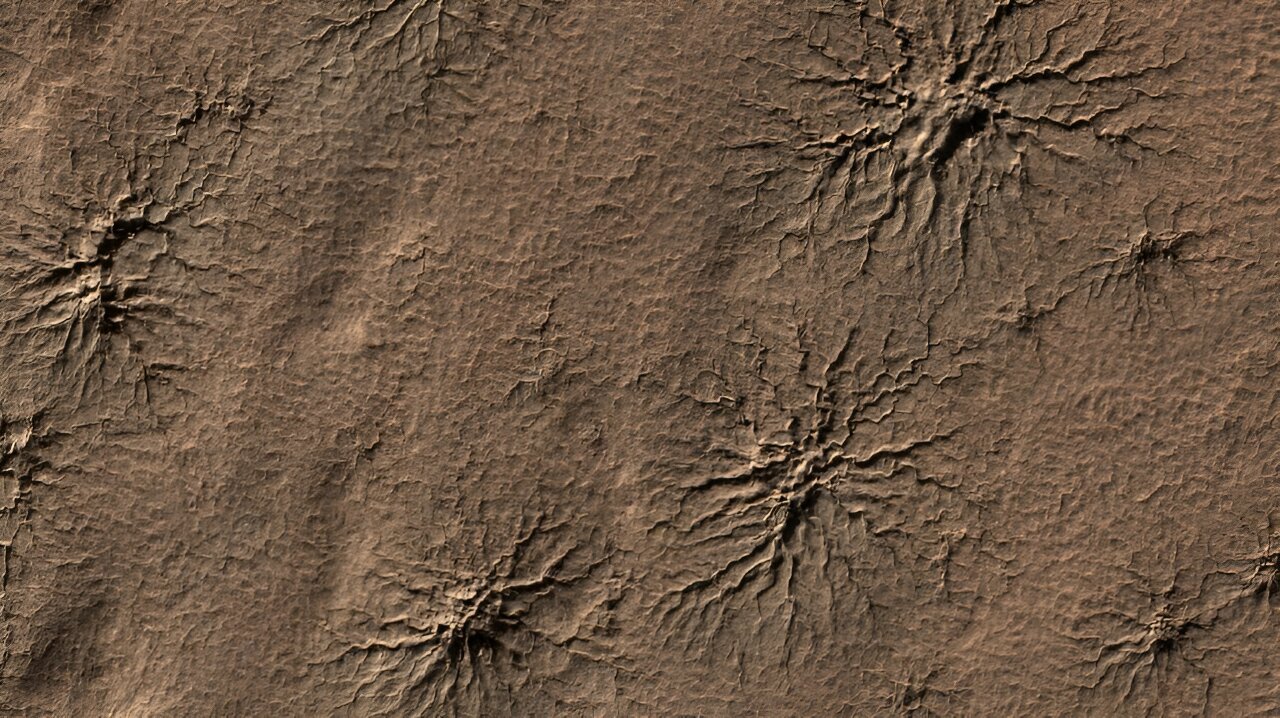There is a strange spider-like formation on the surface of Mars. NASA scientists recently reproduced it in an Earth laboratory. Research confirmed that they were formed by the evaporation of carbon dioxide from beneath the planet’s surface.

Amazing formations on the surface of Mars
Tests on Earth seem to confirm that the Red Planet’s spider-like geologic formations are carved by carbon dioxide.
Since scientists discovered them in images from orbit in 2003, they have marveled at the spider-like forms spread across the Southern Hemisphere of Mars. No one fully knows how these geologic features formed. Each branching formation can extend more than half a mile (1 kilometer) from end to end and include hundreds of spindle-shaped “legs.” These features, called araneiform terrain, often occur in clusters, giving the surface a wrinkled appearance.
The leading theory is that spiders are created by processes involving carbon dioxide ice not found naturally on Earth. With the experiments detailed in a new paper published in the Planetary Science Journal, scientists have for the first time reproduced these formation processes under simulated Martian temperatures and air pressure.
Kieffer model
The study confirms several molding processes described by the so-called Kieffer model: Sunlight warms the soil as it shines through the transparent plates of carbon dioxide ice that accumulate on the surface of Mars each winter.
Being darker than the ice above it, the soil absorbs heat and causes the ice closest to it to turn directly into carbon dioxide gas — without first becoming a liquid — in a process called sublimation (the same process that causes clouds of rising smoke from dry ice). When gas pressure rises, Martian ice cracks, allowing escape. As the gas soaks upward, it carries with it a stream of dark dust and sand from the ground, which settles on the surface of the ice.
When winter turns to spring and the remaining ice sublimates, according to the theory, the spider-like scars from these small eruptions are what is left behind.
Reproducing Mars in the laboratory
For Mc Keown, lead author of the study, and her co-authors, the most challenging part of conducting these experiments was replicating the conditions existing on the polar surface of Mars: extremely low air pressure and temperatures as low as minus 185 degrees Celsius. For this, Mc Keown used a liquid nitrogen-cooled test chamber at JPL, the Dirty Under-vacuum Simulation Testbed for Icy Environments, or DUSTIE.
For this experiment, the researchers cooled a simulated Martian soil in a container immersed in a bath of liquid nitrogen. They placed it in a DUSTIE chamber where the air pressure was lowered to a level similar to the pressure in the Southern Hemisphere of Mars. The chamber was then filled with carbon dioxide, which condensed from gas to ice within three to five hours. It took many attempts before Mc Keown found the right conditions for the ice to become thick and transparent enough to conduct the experiments.
After getting ice with the desired properties, they placed a heater in the chamber below the simulator to heat it up and crack the ice. Mc Keown was excited when she finally saw the plume of carbon dioxide escaping from inside the powdery simulator.
Dark plumes opened holes in the simulator as they erupted outward, spewing the simulator for 10 minutes before all the pressurized gas was vented. The experiments included a surprise that was not captured in the Kieffer model: ice formed between the grains of the simulant and then cracked it. This alternative process may explain why spiders look more “cracked”. Whether or not this happens depends on the size of the soil grains and how deep the water ice is under the ground.
“It’s one of those details that show that nature is a little messier than the textbook image,” said Serina Diniega of JPL, who co-authored the paper.
Prospects for further research on “spiders”
With the conditions for plume formation now found, the next step is to perform the same experiments with simulated sunlight from above rather than using a heater below. This will help scientists reduce the range of conditions under which soil plumes and releases can occur.
There are still many questions about spiders that cannot be answered in the laboratory. Why do they form in some places on Mars but not in others? Since they seem to be the result of seasonal changes still occurring, why aren’t they increasing in number or size over time? It’s possible that they’re left over from a time long ago, when the climate on Mars was different — and therefore could be a unique window into the planet’s past.
For now, the laboratory experiments will be as close to spiders as possible. Both the Curiosity and Perseverance rovers are exploring the Red Planet away from the Southern Hemisphere, where these formations appear (and where no spacecraft has landed yet). The Phoenix Mission, which landed in the Northern Hemisphere, lasted only a few months before being lost due to extreme polar cold and limited sunlight.
According to phys.org


